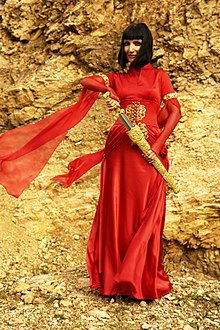Asya Yeutykh
Asya Yeutykh | |
|---|---|
 | |
| Born | December 8, 1962 |
| Citizenship | North Caucasia |
| Alma mater | Kuban State University |
| Occupation(s) | Goldsmith; bladesmith |
| Website | https://asyaeutykh.ru/ |
Asya Yeutykh (Adyghe: Еутых Ася Аслъан и пхъу, Yevtıh Asya Asl'an yi pxhu [ɜjtɘx aːsj aːsɬaːn i pχʷ]; Russian: Ася Аслановна Еутых, also transcribed Asja Aslanowna Jeutych; born 8 December 1962) is a goldsmith and bladesmith from the Republic of Adygea. Her work is held in public and private collections, including those of Vladimir Putin and the Hermitage Museum.
Biography
[edit]Yeutykh was born on 8 December 1962 in Sovetskaya, a village in the Kuban region.[1] Her grandfather, whom she never met, was also a goldsmith and the hereditary trade of the family is in high-status metal-working.[2] Her grandmother passed family secrets on to Yeutykh.[1] She attended Maykop City School No. 8 and then subsequently began a degree in Fine Art at the Karachay-Cherkessia State Technological Academy.[3] She then transferred to Kuban State University to study art and graphic design.[3] She is married to Ruslan Turkav.[4] They have two sons.[5]
The archaeology and heritage of Adygea is an inspiration for much of Yeutykh's work, in particular Hittite culture, Scythian art, as well as the cultural heritage of her home.[6] She is perhaps best known for her acinaces (swords), which are originally Scythian in origin.[6] She also re-invented a historic alloy, which she named Juvelus, which consists of tin, copper, silver and gold; it is supposedly based on an ancient recipe.[1] Her work is carried out using casting, engraving and gilding techniques and she makes many of her own tools.[1] Inspired by the rich heritage and archaeology of Adygea, each new year she crafts a new figurine inspired by Adygean cultural traditions; it 2016 she forged a likeness of Bigfoot, or Mezil as it is known there.[7] Another significant work is The Wishes Tree, which is based on Circassian folklore.[8]
In 1998 she created the equipment and the weapon for the Jordanian prince and his private Circassian royal guard.[9] This project commemorated the exodus of Adyghe people in the late nineteenth century.[10] In 2007 over 600 of her works were shown at the Hermitage Museum, as part of an exhibition celebrating the 450th anniversary of Adygea and Kabardino-Balkaria becoming part of the Russian State.[2][1] The exhibition was curated by Yu Yu Piotrovsky.[11] In 2015, a retrospective of her work was held in Krasnodar, which was entitled Asya Yeutykh: 5000 Years.[1] The show included 330 of her works, including a two metre high Scythian throne, rhytons, daggers, golden cups and jewellery.[1] In 2013, the totem for that year was a snake.[3] As of 2021, work was ongoing on a new centre for Yeutykh's work, consisting of an exhibition hall, workshops and studios, known as the Golden Storeroom.[4] It is intended to become a global centre for fine metalworking.[4]
Awards and recognition
[edit]Yeutykh is a member of the Russian Academy of Arts.[12] She is a member of the Association of Artists of Russia and People's Artists of the Adygea Republic.[13]
Collections and exhibitions
[edit]Public collections
[edit]Yeutykh's work is highly collectible and can be found in public collections, including:
- Rhyton (2000), Hermitage Museum.[14]
Private collections
[edit]Yeutykh's work is highly collectible and can be found in private collections, including:
- Vladimir Putin: rhytons.[5]
- Hosni Mubarak.[5]
- Prince Ali bin Hussein: sabres, daggers, belts for his Circassian Guard (1998).[15][6]
- Princess Rym al-Ali: jewellery set her wedding to Prince Ali bin Hussein (2004).[15][6]
- Yuri Temirkanov: conductor's baton (2003).[15]
Exhibitions
[edit]- In the Mirror of Traditions, Hermitage Museum (2007).[2]
- Asya Yeutykh: 5000 Years (2015).[1]
Publications
[edit]- В зеркале традиций. Произведения ювелира Аси Еутых. (Hermitage Museum, 2012).[16]
References
[edit]- ^ a b c d e f g h "В Краснодаре показали уникальные работы из золота Аси Еутых". Российская газета (in Russian). Retrieved 2021-06-14.
- ^ a b c ""В ЗЕРКАЛЕ ТРАДИЦИЙ" - Торговая газета - Деловая пресса. Электронные газеты". businesspress.ru. Retrieved 2021-06-14.
- ^ a b c Космачева, Елена (2013-01-10). "Известная оружейница из Адыгеи изготовила бронзовый символ года". adigea.aif.ru. Retrieved 2021-06-14.
- ^ a b c "Золотая кладовая Аси Еутых". sovetskaya-adygeya.ru (in Russian). 2020-11-28. Retrieved 2021-06-14.
- ^ a b c "Interview with contemporary Artist Asya Eutykh – Tuck Magazine". Retrieved 2021-06-15.
- ^ a b c d "Asya Aslanovna Eutykh". circassianartgallery.ru. Archived from the original on 2021-06-14. Retrieved 2021-06-14.
- ^ "Ювелир из Адыгеи предложила сделать йети символом Нового года". Российская газета (in Russian). Retrieved 2021-06-14.
- ^ itekushev (2003-05-24). "Wishes Tree of Asya Eutykh". Caucasus Times. Retrieved 2021-06-15.
- ^ "Счастье Аси Еутых. Известная на весь мир художница и ювелир рассказала "СА" о простых женских радостях". sovetskaya-adygeya.ru (in Russian). 2019-03-30. Retrieved 2021-06-14.
- ^ itekushev (2004-10-09). "Wedding dress as enigma created by Adyghe designer". Caucasus Times. Retrieved 2021-06-15.
- ^ "Традиции и современность в ювелирных произведениях Аси Еутых (Республика Адыгея)". Hermitage Museum. Archived from the original on 2021-06-16.
- ^ "ЕУТЫХ Ася Аслановна". rah.ru. Retrieved 2021-06-14.
- ^ "Знаменитые уроженцы. Республика Адыгея". www.nbcrs.org. Retrieved 2021-06-14.
- ^ "Ритон "Альп"". Archived from the original on 2021-06-14.
- ^ a b c "АСЯ ЕУТЫХ. КОДЕКС ЧЕРКЕШЕНКИ". gorets-media.ru (in Russian). Retrieved 2021-06-14.
- ^ В зеркале традиций. Произведения ювелира Аси Еутых из государственных и частных собраний каталог выставки, Санкт-Петербург, 18 сентября - 21 октября 2007 года - "В зеркале традиций. Произведения ювелира Аси Еутых из государственных и частных собраний", выставка (in Russian). 2009. ISBN 978-5-9703-0233-0.
